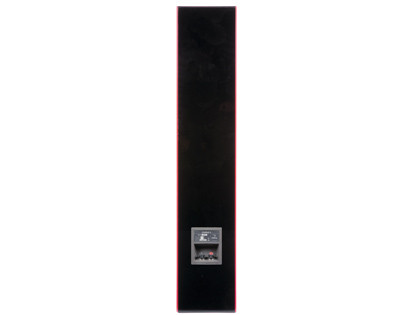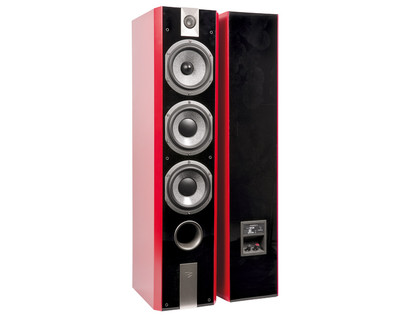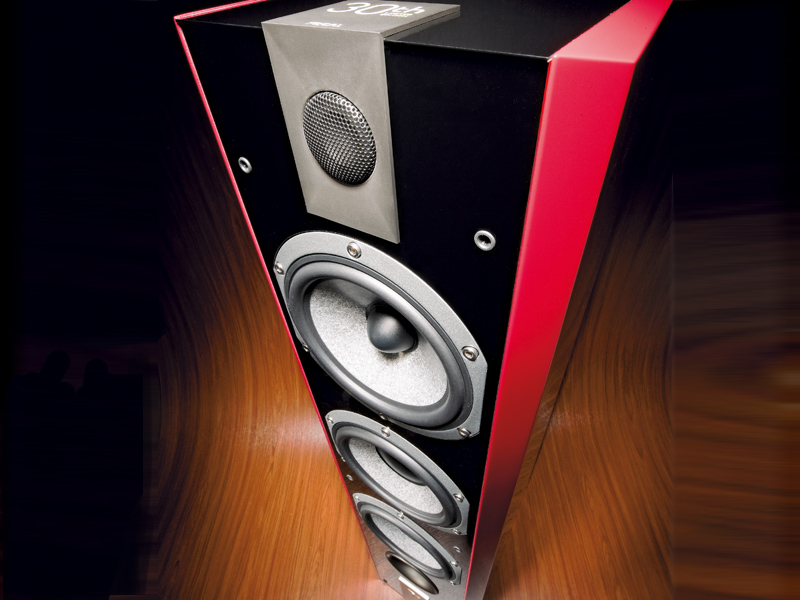TechRadar Verdict
With the addition of W cones, Focal has turbo charged the 826. It does energy and excitement, as well as the fine detail of voices and instruments. This, plus the great looks, make it a serious contender for your money
Pros
- +
Enthusiastic and revealing loudspeaker
- +
Tremendous build quality
- +
Fine grasp of timing
- +
Easy to drive
Cons
- -
A little coloured through the upper bass when driven hard
- -
Possibly too exuberant for some tastes
Why you can trust TechRadar
A red loudspeaker on these conservative shores! Is Focal having a laugh? It would seem not, but the company did get caught out. It ordered lots of satin-black stock, only to find that dealers actually like the red version instead. So, perhaps, British tastes are not so unadventurous as they sometimes seem.
The red looks superb and is rather less pillar box in the flesh than it appears in the company's literature. There it's called satin imperial red and has a depth to it that's highly seductive.
This new limited edition version of the Focal Chorus 826 floorstander was produced to celebrate 30 years since Jacques Mahul started Focal-JMLab in St Etienne with one employee back in 1978. A few more years (and employees) later and focal now has 15 per cent of the domestic market with the majority of its turnover made for export.
There is a standard version of this speaker called the Chorus 826 V and that costs some £530 less than this W LE version, so what's the deal?
Well, the deal is in the letter W – this indicates the presence of W composite cones in the bass and midrange drivers. This is the cone type found in Focal's Electra range, which starts at £2,649 (for the standmount 1008 BE 2), and replaces the polyglass cones of the standard version.
A 'W' cone is a sandwich of glass fibre skins with a foam core, a combination which provides high stiffness in a very light cone. In this instance, new W cones have been produced to suit the 826 with a different thickness of glass leaf skin and a foam thickness that matches the acoustic requirements of this particular loudspeaker.
It's surprising that three cones per side can make this much difference to the price of the speaker, but this is partly because focal makes all its own drivers in France – which like the rest of Europe is an expensive place to manufacture. Divide £530 by six to get just over £88, so if you factor in distributor and dealer margins, this starts to look more reasonable.
Sign up for breaking news, reviews, opinion, top tech deals, and more.
The most convincing argument for paying the extra, however, is the sound, but we'll come to that shortly.
The Chorus 826 is a well-proportioned speaker that sits on a cast alloy base, which leaves a gap for the downward firing reflex port to vent through. A second port fires forwards – this is a speaker that likes to breathe.
The base, which is bolted on, has easy to adjust spikes in its four corners. These have a Torx socket for which the appropriate key is supplied. The key can be kept in the grille. The MDF cabinet is built with non-parallel inner walls to minimise internal reflections and damped with acoustic wadding.
Externally, it's flanked by wedge-shaped panels, which give the cabinet an attractively stealthy shape and just might help with imaging. The central section is finished in black acrylic, which looks fabulous and adds a bit more stiffness than a veneer.
Connections are of the single pair variety, because focal would rather you used a single type of speaker cable only. It obviously doesn't like the idea of someone bi-wiring with different cable flavours and changing the sound in an unpredictable way!

The drive units start with a pair of 165mm bass units using the aforementioned W cones. Their centres are covered by a large and relatively flat dust cap. At 300hz, these hand over to another 165mm cone, but one with a phase plug at its centre, which covers the midband up to 3khz. From there, duties are taken on by one of focal's signature inverted metal dome tweeters – this is the aluminium and magnesium example found across the chorus 800 range.
The theory behind the inverted dome is that it allows optimal energy transfer from the voice coil to produce wide dispersion – a theory that has been accepted by Wilson Audio, which uses focal tweeters in its high-end speakers.
Sound quality
Focal is keen to point out that the W cone drivers in this speaker take a while to adapt to their environment, by which it means the temperature and the humidity, rather than the colour scheme of your living room. They certainly sounded a bit more relaxed after a few days in the well-damped environs of our dark and mysterious listening room.
It's been a long time since we heard the standard 826, but it never sounded like this W LE version. This thing has incredible get up and go, a vivacity and turn of pace that refuses to be ignored, a little excitable perhaps, but very exciting. There's something Tiggerish about it to be honest – it wants to bounce with the music thanks to the way those W cones can stop and start with such alacrity.
The degree to which this is the case varies quite considerably with how it's placed in the room and what amp you drive it with. With a calmer amp you get a more restrained result, but with something dynamic like the Mimetism 15.2 there's a liveliness to the music that is addictive.
It's not all energy, however. Energy is very appealing but it can become a little wearing over time if not tempered by some finesse. Fortunately, the 826 W LE is not unsubtle and can resolve fine detail with relative ease. It proved quite easy, for instance, to differentiate like-priced CD players in terms of image solidity and tonal rendering.
If anything, this speaker needs a refined source to temper some of its exuberance, but that is probably a matter of taste. If you want a thrill-powered musical experience, then a dynamic front end will do the trick.
Part of the reason for the taut, fast sound of this speaker is its relatively lean bass. It extends down adequately for its size, but does not push for more depth in the way that standmounts and some floorstanders often do. It trades off floor-shaking powers for nimbleness.
You can fine tune this balance with proximity to the wall. The closer it gets to room boundaries, the weightier the bass becomes at the expense of speed. As the latter is the rather more enticing quality, the tendency is to give the speaker room to manoeuvre. Then you can hear the harmonics more clearly, thanks to extra midband openness – something that this focal excels in.
It's also very strong on timbre so it's easy to pick out the character of different acoustic guitars when they are playing together, for instance, and there's plenty of differentiation between voices.
Bringing in a real world amplifier, in the shape of Arcam's well-regarded A38, inevitably reduces the thrill power as a £4,000 drop in price usually will, but the result remains informative and engaging. The speakers turn in excellent pace and good scale whenever the recording has it to offer.

One piece, the female voice and piano of Schubert's Winterreise (performers: Schäfer/Schneider) is positively beautiful thanks to remarkably open, full scale imaging and a well-judged tonal balance. The Cyrus transport and DAC source was probably also beneficial in this instance; its unusually clean character proving well-suited to this superb recording.
Under the harshest conditions we can muster – a single speaker in the middle of the room, which is about the most revealing way to assess a speaker – the 826W reveals a slight boxiness that's evident in a tendency toward imprecision in the upper bass, and a degree of loudness. By comparison, PMC's smaller and less expensive GB1 is a little cleaner, though the mid and bass lines are a bit tidier and only slightly less extended.
So if it has a weakness, it is towards exuberance and that's hardly a sin. In practice, it makes for tremendously entertaining and engaging music that revels in fine detail as well as energy. This combined with its remarkable build quality for the money, makes the 826W LE something of a bargain and a great looking one at that.
Follow TechRadar Reviews on Twitter: http://twitter.com/techradarreview
